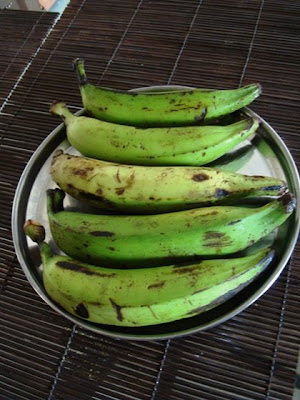.
Food is one area where my husband and I are poles apart (although our horoscopes show samasaptakam, or perfect agreement between our stars!).
.
While I am a foodie, my husband believes that one should eat only to live. Recently, he had a minor surgery, after which he was advised to eat a nutritious diet with plenty of milk, vegetables and fruits. This is where the Nendrampazham came to my rescue. The only fruit that my husband eats with delight is this king of bananas, a big yellow variety that is also called 'Rajali Kela' in Mumbai.



Ready to eat!
My younger granddaughter likes to have bananas sliced into thinnish circles, and stir fried in ghee. She eats it with a fork, Western style. But my older granddaughter loves banana chips. These are made using the raw version of these bananas, by slicing it very thin, and deep frying it in oil.
Nendrankkai - the raw version of Nendrampazham
My mother was an expert in making banana chips (and my father in distributing it among his office friends). As a young girl, whenever we heard a hissing sound coming from the kitchen, I was sure that my mother was busy making chips. The hissing sound comes at the last stage of making these chips, when salt water is poured on the chips before pulling them out of the oil.
That is what differentiates the traditional home-made chips from the ones we buy in Matunga market. In the market, the salt is added later, after the chips are taken out of the oil.



Banana varieties in Matunga Market
Nendrankkais are also used to make many Kerala specialities - erisseri and kaalan are my favourites. Even the skin is cut into tiny bits and converted into a tempting side-dish. No wonder this banana is called 'Rajali' - it is truly the King of Bananas!





